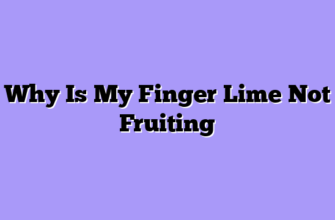After fifteen years of growing exotic fruits on my small farm in Northern California, I can tell you that finger limes have become my most prized crop – and my most challenging one to master. These little Australian natives, often called “citrus caviar,” have taught me patience like no other fruit I’ve grown. If you’ve ever wondered when these peculiar elongated citrus fruits are ready for harvest, let me share what I’ve learned through countless seasons of trial, error, and eventual triumph.
When I first planted my finger lime trees five years ago, I made every mistake in the book. I picked them too early, too late, and sometimes forgot about them entirely until they dropped to the ground like tiny green grenades. But here’s the thing about farming – every mistake teaches you something valuable, and finger limes are excellent teachers if you’re willing to listen.
The Art of Reading Your Finger Limes
You know how wine connoisseurs talk about terroir? Well, finger limes have their own version of that story written right on their skin. The first thing I learned was to stop thinking of these fruits like regular limes or lemons. They’re completely different beasts, and they’ll humble you quickly if you approach them with conventional citrus wisdom.
The color transformation is your first clue, but it’s not as straightforward as you might think. My finger limes range from deep forest green to burgundy, yellow, and even pink, depending on the variety. But here’s the kicker – the color change isn’t always dramatic. Sometimes it’s subtle, like watching the sun set through heavy clouds. You have to train your eye to catch these nuanced shifts.

The texture test became my secret weapon. Gently squeeze the fruit – and I mean gently, like you’re testing a ripe avocado for your morning toast. A ready finger lime yields just slightly to pressure, giving you that perfect balance between firmness and give. Too hard, and you’re looking at sour disappointment. Too soft, and you’ve missed the window – the vesicles inside will have lost their pop and turned mushy.
But here’s where it gets interesting: the stem tells its own story. When finger limes are ready, the stem connection becomes more fragile. It’s nature’s way of preparing for the fruit to release. I’ve learned to look for a slight browning or drying at the stem end. If the fruit practically falls into your hand with the gentlest twist, you’ve hit the sweet spot.
Timing is Everything: My Seasonal Strategy
Living in Northern California gives me a longer harvesting season than most places, but even here, timing varies dramatically based on microclimates and individual tree health. My trees typically start producing ripe fruit in late summer, with the peak season running from September through December. However, I’ve had surprise harvests as late as February during particularly mild winters.
Here’s my harvesting schedule that’s evolved over the years:
- Morning harvests only: The fruit is firmer and handles better when it’s cool
- Weekly inspection walks: I check each tree systematically, marking promising candidates with colored ribbon
- Temperature monitoring: I never harvest when it’s above 85°F or below 40°F
- Post-rain waiting period: I wait at least 48 hours after heavy rain before harvesting
The numbered approach I follow for each harvest day:
- Visual scan first: Walk the entire grove noting overall tree health and fruit development
- Individual tree assessment: Check marked fruits from previous week for progress
- Gentle testing: Use the squeeze and twist method on promising candidates
- Immediate processing: Get harvested fruit to cool storage within 30 minutes
- Documentation: Record harvest quantities and quality notes for future reference
What surprised me most was learning that finger limes don’t all ripen uniformly on the same tree. Unlike apples or oranges that might have a clear harvest window, my finger lime trees are like slow-motion Christmas lights – individual fruits reaching peak ripeness over several weeks. This means I’m out there almost daily during peak season, which honestly has become one of my favorite parts of farming.
The Investment That Pays Off
Let me be honest with you – finger lime farming isn’t for the impatient or the faint of heart. These trees are slow to establish, particular about their growing conditions, and the fruit commands premium prices precisely because they’re challenging to grow well. But when you crack open a perfectly ripe finger lime and those little vesicles burst on your tongue like citrus pearls, you understand why top chefs pay $40 per pound for them.
| Harvest Timing Indicators | Ready to Pick | Wait Longer | Past Prime |
|---|---|---|---|
| Skin texture | Slight give when squeezed | Rock hard | Very soft/squishy |
| Color intensity | Softened, muted tones | Bright, harsh colors | Dull, faded appearance |
| Stem connection | Easily detaches with gentle twist | Firmly attached | Falls off on its own |
| Size | Plump, filled out | Still growing | Shriveling |
The learning curve with finger limes taught me something profound about farming in general. Sometimes the most valuable crops are the ones that force you to slow down, pay attention, and develop an almost intuitive relationship with your plants. I can now walk through my finger lime grove and sense which fruits are ready without even touching them. It’s like having a conversation with the trees – they tell you their stories if you know how to listen.

The next time you see finger limes at a farmer’s market or specialty store, remember that each one represents weeks of careful observation and patience. And if you’re thinking about growing your own, be prepared for a journey that’s equal parts frustrating and rewarding – but absolutely worth every moment spent learning their secrets.








